
T
ẠP CHÍ KHOA HỌC
TRƯ
ỜNG ĐẠI HỌC SƯ PHẠM TP HỒ CHÍ MINH
Tập 21, Số 9 (2024): 1738-1748
HO CHI MINH CITY UNIVERSITY OF EDUCATION
JOURNAL OF SCIENCE
Vol. 21, No. 9 (2024): 1738-1748
ISSN:
2734-9918
Websit
e: https://journal.hcmue.edu.vn https://doi.org/10.54607/hcmue.js.21.9.4470(2024)
1738
Research Article1
A LOOK AT THE FAMILY STRUCTURE
AND CINEMATIC IDEOLOGY IN DIRECTOR ANG LEE’S FILMS:
LIFE BETWEEN TWO WORLDS
Phan Thu Van
Ho Chi Minh City University of Education, Vietnam
=Corresponding author: Phan Thu Van – Email: vanpth@hcmue.edu.vn
Received: July 30, 2024; Revised: August 15, 2024; Accepted: September 28, 2024
ABSTRACT
This article analyses the family structure commonly seen in director Ang Lee's trilogy of films
about families (Pushing Hands (1991), The Wedding Banquet (1993), Eat Drink Man Woman (1994),
also known as Ang Lee's family trilogy or "Father Knows Best Trilogy") and divides them into three
types of structures: the missing structure, the swap structure, and the fusion structure. It also
explores the way Lee uses his films as a means to express his ideas about the way certain Asian
families struggle to incorporate a combination of Eastern and Western ideology, as well as
traditional and modern thought.
Keywords: family structure; cinematic ideology; Ang Lee; Pushing Hands; The Wedding
Banquet; Eat Drink Man Woman
1. Introduction
“Family” is a popular topic in cinema, but one that can prove both challenging and
interesting (in equal measure). Everyone in society has a family and their concept of family.
This is true, of course, of Ang Lee as well, and his movies express his personal feelings and
thoughts about the subject represented on the big screen.
Ang Lee started his career with three films about Taiwanese or Mainland Chinese
families living in Taiwan and the United States: Pushing Hands (1991), The Wedding
Banquet (1993), and Eat Drink Man Woman (1994). These three films share a standard
ideological circuit related to Eastern family traditions facing the changes of the times. Each
one tends to focus on the father (or patriarchal/masculine ideology) as the basis for the
development of conflicts.
There have been many critical studies on Ang Lee's films. Still, none have focused on
analysing the family and his ideological aspects, nor have any studies examined the use of
Cite this article as: Phan Thu Van (2024). A look at the family structure and cinematic ideology in director
Ang Lee’s films: Life between two worlds. Ho Chi Minh City University of Education Journal of Science,
21(9), 1738-1748.

HCMUE Journal of Science
Vol. 21, No. 9(2024): 1738-1748
1739
family structure in his films. The contribution of this work is to find ideological similarities
between the films. In his movies, he places the family between the East and West worlds to
forge a better understanding of the connection (and correlation) between tradition and
modernity.
2. Research Objects and Methods
The research objects of this article are the the family structure and cinematic ideology
of Ang Lee in his first three films: Pushing Hands (1991), The Wedding Banquet (1993),
and Eat Drink Man Woman (1994).
The research method used is an interdisciplinary method between cinema, culture and
philosophy to find the connections between the family structure in Ang Lee's cinema and
Eastern and Western thought, thereby establishing Ang Lee's position in the East-West
ideological exchange of world cinema.
3. Results and Discussion
3.1. Results
The family structure in Ang Lee's first three films conveys traditional ideas in the face
of modern challenges and the clash between Eastern and Western cultures.
Ang Lee was born and raised in a traditional family in Taiwan but studied in the US
before becoming successful in Hollywood. His background gives him a rare understanding
of Eastern and Western culture. His work has shown a unique combination of Eastern and
Western ideas, particularly in the search for knowledge and coexistence among people
worldwide.
3.2. Discussion
3.2.1. The ‘missing’ structure
A missing structure family is one in which a critical family member (mother, father,
grandmother, grandfather, a child) is absent. Ang Lee films often focus on the position of
the father or the man in the family, so the image of the mother/wife is typically lacking.
Picture 1. The ‘missing’ structure of Pushing Hands (1991)

HCMUE Journal of Science
Phan Thu Van
1740
An example of this is the way the absence of the mother/wife character in the movie
Pushing Hands (1991) causes Mr. Chu (Sihung Lung), a tai chi master who travels to the
United States, to feel lonely constantly. Meanwhile, his traditional Chinese-style behaviour
creates trouble in his relationship with Martha Chu (Deb Snyder), his American daughter-
in-law, which ultimately forces him to leave their home and go on his own to America, a
foreign land to him.
The unrealised "succession" from father to son can also be seen as a significant flaw
in the family structure according to traditional Asian thinking. Therefore, The Wedding
Banquet (1993) created the reluctant situation of Wai-Tung Gao (Winston Chao) when he
had to organise a wedding with female painter Gu Wei-Wei (May Chin) to hide the fact that
he is gay. It’s illustrative that when Wai-Tung Gao introduces his fiancee to his parents and
his mother (Ah-leh Gua) asks his father (Sihung Lung) what he thinks of his prospective
daughter-in-law, the father answers succinctly: "She can give birth and raise children".
Picture 2. The ‘missing’ structure of The Wedding Banquet (1993)
Another example would be Mr Zhu (Sihung Lung) in the movie Eat Drink Man
Woman (1994), who is also a single father, or, Asians might say, a "rooster raising children"
who tries unsuccessfully for 16 years to overcome his instinctive needs. As a chef, his "loss
of taste" is a subtle metaphor for his struggle to find the meaning of his life and the lack of
joy in the family’s overall life. Five critical scenes from the film revolve around the family
having dinner on Sundays. The father has lost his sense of taste from the first meal scene.
The fact that a chef who has lost his sense of taste can still display his talent by cooking a
meal full of delicious-looking dishes is impressive, but the soul of the dish is no longer there.
In the same way, the family reunites to eat a hearty meal, but everyone keeps their distance
and has their plans, like an aesthetically beautiful meal that somehow lacks "flavour".

HCMUE Journal of Science
Vol. 21, No. 9(2024): 1738-1748
1741
Picture 3. The ‘missing’ structure of Eat Drink Man Woman (1994)
Eat Drink Man Woman (1994) also shows Mr. Zhu's secret wish for a son. While he
does not admit this, the fact that he chooses a woman of childbearing age (the same age as
his daughter) to build a family, researches remedies for kidney tonics, diligently works to
maintain optimal health, etc., reveals that he still wants to “try his luck" at the end of his life,
even though he already has three daughters.
3.2.2. The ‘swap’ structure
The swap structure reflects when a family member or members attempt to fill the void
left by the ‘missing’ family member from the ‘missing’ structure.
The father in Eat Drink Man Woman (1994) stands up for himself as the ‘mother’ of
three daughters. In the morning, he enters each room to wake his daughters before lapping
their underwear with a slightly confused and resigned expression, showing his discomfort in
the role. He has to suppress his private desires to handle the responsibilities of being a busy
‘housewife’: cooking, washing dishes and clothes, and only jogging or doing other activities
when he has time... His family is a traditional family, reflected by their habit of gathering
around a large dining table and the old-fashioned style exhibited by the three daughters. The
lack of a son is a vacancy. Everyone notices the elephant in the room, even though no one
mentions it.
The eldest daughter, Zhu Jia-Jen (Kuei-mei Yang), who has a strong desire for love
hidden under her rigid shell, is not the right person to shoulder the burden of family
succession. Unconsciously, she also tries to play the role of a mother by dressing like an
elder, always sitting next to her father at meals, being strict with her sister, and never having
boyfriends. But this is an incomplete exchange or “swap”, as she does not know how to
express her feelings to people adequately, and at the same time, cannot act as a wife in the

HCMUE Journal of Science
Phan Thu Van
1742
family but can only be an ally of her father on the battlefield of the suppression of his
personal feelings. The youngest daughter Zhu Jia-Ning (Yu-wen Wang), lacked her mother's
love all her life, so when she becomes an adult, she is the most decisive person when it comes
to the desire to leave the existing family to build a new family and quickly become a mother.
Only the second daughter, Zhu Jia-Chien (Chien-lien Wu), who looks exactly like her
deceased mother and wants to follow her father's culinary career, can fill the void. She plans
to use her career and cooking prowess to compete for her father's love. By the end of the
film, she is the only one who successfully "swaps" to the position of her father's son. In doing
so, she also gives up the opportunity to go abroad, instead staying in the house where only
she and her father are left. The final scene, where she cooks a delicious dish for her father
and helps him regain his taste and spirit, represents the meaning of family and life.
Picture 4. The ‘swap’ structure of Eat Drink Man Woman (1994)
The end of the movie Eat Drink Man Woman (1994) shows that each character has
returned to their proper position: the newly remarried father builds a family as a husband,
the eldest sister builds a family as a mother (controlling and guiding her new husband), the
youngest builds a family with the role of a woman (pregnant, pampered and protected), while
the second sister is alone in the house, having filled the succession role of "inheriting"
the house.
The swap structure can also be reflected in a situation involving a ‘gender swap’ or the
compensation in the character's psychology. The father's decision to ultimately live with his
daughter's schoolmate represents a shift of "incest" feelings in the subconscious. Meanwhile,
his young wife-to-be, the character Liang Jin-Rong (Sylvia Chang), who ‘lost’ her father at
a young age after a divorce, has moved on to a partner the same age as her father, expressing
the emotional void in her subconscious.

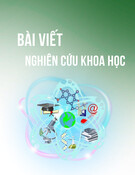



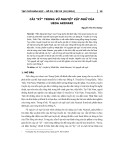


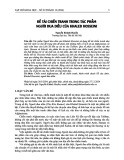
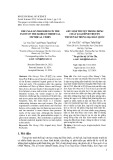
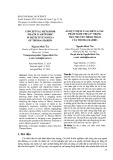
![Bộ câu hỏi trắc nghiệm Văn bản tiếng Việt [chuẩn nhất]](https://cdn.tailieu.vn/images/document/thumbnail/2025/20251127/thuynhung051106@gmail.com/135x160/24021764296609.jpg)


![Bài giảng Ngôn ngữ học đối chiếu Nguyễn Ngọc Chinh [PDF]](https://cdn.tailieu.vn/images/document/thumbnail/2025/20251101/vovu03/135x160/7471762139652.jpg)


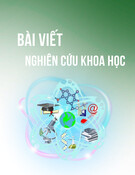

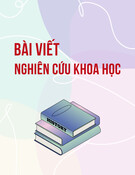
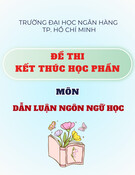

![Ngân hàng câu hỏi môn Tiếng Việt thực hành [chuẩn nhất]](https://cdn.tailieu.vn/images/document/thumbnail/2025/20251003/kimphuong1001/135x160/21861759464951.jpg)
![Bài giảng Văn học phương Tây và Mỹ Latinh [Tập hợp]](https://cdn.tailieu.vn/images/document/thumbnail/2025/20251003/kimphuong1001/135x160/31341759476045.jpg)


